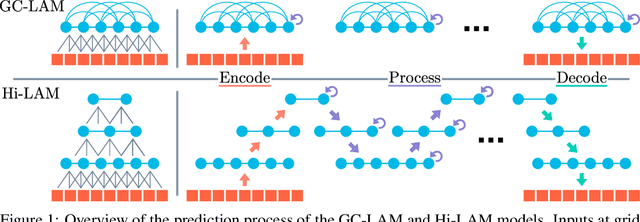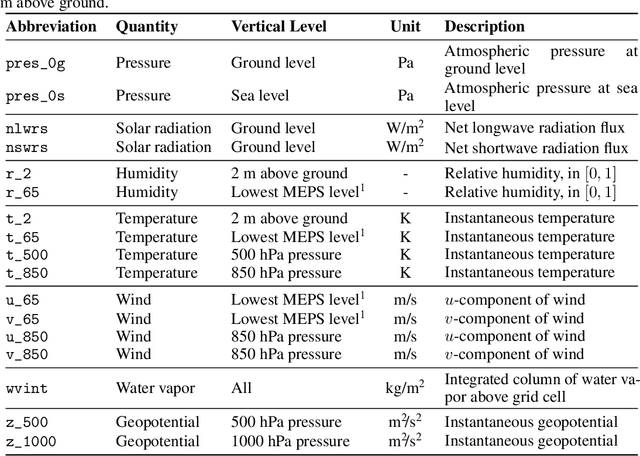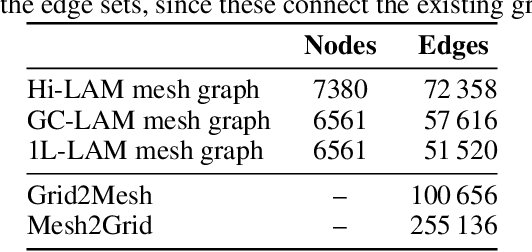Joel Oskarsson
CRPS-LAM: Regional ensemble weather forecasting from matching marginals
Oct 10, 2025Abstract:Machine learning for weather prediction increasingly relies on ensemble methods to provide probabilistic forecasts. Diffusion-based models have shown strong performance in Limited-Area Modeling (LAM) but remain computationally expensive at sampling time. Building on the success of global weather forecasting models trained based on Continuous Ranked Probability Score (CRPS), we introduce CRPS-LAM, a probabilistic LAM forecasting model trained with a CRPS-based objective. By sampling and injecting a single latent noise vector into the model, CRPS-LAM generates ensemble members in a single forward pass, achieving sampling speeds up to 39 times faster than a diffusion-based model. We evaluate the model on the MEPS regional dataset, where CRPS-LAM matches the low errors of diffusion models. By retaining also fine-scale forecast details, the method stands out as an effective approach for probabilistic regional weather forecasting
Building Machine Learning Limited Area Models: Kilometer-Scale Weather Forecasting in Realistic Settings
Apr 12, 2025



Abstract:Machine learning is revolutionizing global weather forecasting, with models that efficiently produce highly accurate forecasts. Apart from global forecasting there is also a large value in high-resolution regional weather forecasts, focusing on accurate simulations of the atmosphere for a limited area. Initial attempts have been made to use machine learning for such limited area scenarios, but these experiments do not consider realistic forecasting settings and do not investigate the many design choices involved. We present a framework for building kilometer-scale machine learning limited area models with boundary conditions imposed through a flexible boundary forcing method. This enables boundary conditions defined either from reanalysis or operational forecast data. Our approach employs specialized graph constructions with rectangular and triangular meshes, along with multi-step rollout training strategies to improve temporal consistency. We perform systematic evaluation of different design choices, including the boundary width, graph construction and boundary forcing integration. Models are evaluated across both a Danish and a Swiss domain, two regions that exhibit different orographical characteristics. Verification is performed against both gridded analysis data and in-situ observations, including a case study for the storm Ciara in February 2020. Both models achieve skillful predictions across a wide range of variables, with our Swiss model outperforming the numerical weather prediction baseline for key surface variables. With their substantially lower computational cost, our findings demonstrate great potential for machine learning limited area models in the future of regional weather forecasting.
Diffusion-LAM: Probabilistic Limited Area Weather Forecasting with Diffusion
Feb 11, 2025Abstract:Machine learning methods have been shown to be effective for weather forecasting, based on the speed and accuracy compared to traditional numerical models. While early efforts primarily concentrated on deterministic predictions, the field has increasingly shifted toward probabilistic forecasting to better capture the forecast uncertainty. Most machine learning-based models have been designed for global-scale predictions, with only limited work targeting regional or limited area forecasting, which allows more specialized and flexible modeling for specific locations. This work introduces Diffusion-LAM, a probabilistic limited area weather model leveraging conditional diffusion. By conditioning on boundary data from surrounding regions, our approach generates forecasts within a defined area. Experimental results on the MEPS limited area dataset demonstrate the potential of Diffusion-LAM to deliver accurate probabilistic forecasts, highlighting its promise for limited-area weather prediction.
Continuous Ensemble Weather Forecasting with Diffusion models
Oct 07, 2024Abstract:Weather forecasting has seen a shift in methods from numerical simulations to data-driven systems. While initial research in the area focused on deterministic forecasting, recent works have used diffusion models to produce skillful ensemble forecasts. These models are trained on a single forecasting step and rolled out autoregressively. However, they are computationally expensive and accumulate errors for high temporal resolution due to the many rollout steps. We address these limitations with Continuous Ensemble Forecasting, a novel and flexible method for sampling ensemble forecasts in diffusion models. The method can generate temporally consistent ensemble trajectories completely in parallel, with no autoregressive steps. Continuous Ensemble Forecasting can also be combined with autoregressive rollouts to yield forecasts at an arbitrary fine temporal resolution without sacrificing accuracy. We demonstrate that the method achieves competitive results for global weather forecasting with good probabilistic properties.
Uncertainty Quantification of Pre-Trained and Fine-Tuned Surrogate Models using Conformal Prediction
Aug 19, 2024Abstract:Data-driven surrogate models have shown immense potential as quick, inexpensive approximations to complex numerical and experimental modelling tasks. However, most surrogate models characterising physical systems do not quantify their uncertainty, rendering their predictions unreliable, and needing further validation. Though Bayesian approximations offer some solace in estimating the error associated with these models, they cannot provide they cannot provide guarantees, and the quality of their inferences depends on the availability of prior information and good approximations to posteriors for complex problems. This is particularly pertinent to multi-variable or spatio-temporal problems. Our work constructs and formalises a conformal prediction framework that satisfies marginal coverage for spatio-temporal predictions in a model-agnostic manner, requiring near-zero computational costs. The paper provides an extensive empirical study of the application of the framework to ascertain valid error bars that provide guaranteed coverage across the surrogate model's domain of operation. The application scope of our work extends across a large range of spatio-temporal models, ranging from solving partial differential equations to weather forecasting. Through the applications, the paper looks at providing statistically valid error bars for deterministic models, as well as crafting guarantees to the error bars of probabilistic models. The paper concludes with a viable conformal prediction formalisation that provides guaranteed coverage of the surrogate model, regardless of model architecture, and its training regime and is unbothered by the curse of dimensionality.
Probabilistic Weather Forecasting with Hierarchical Graph Neural Networks
Jun 07, 2024Abstract:In recent years, machine learning has established itself as a powerful tool for high-resolution weather forecasting. While most current machine learning models focus on deterministic forecasts, accurately capturing the uncertainty in the chaotic weather system calls for probabilistic modeling. We propose a probabilistic weather forecasting model called Graph-EFM, combining a flexible latent-variable formulation with the successful graph-based forecasting framework. The use of a hierarchical graph construction allows for efficient sampling of spatially coherent forecasts. Requiring only a single forward pass per time step, Graph-EFM allows for fast generation of arbitrarily large ensembles. We experiment with the model on both global and limited area forecasting. Ensemble forecasts from Graph-EFM achieve equivalent or lower errors than comparable deterministic models, with the added benefit of accurately capturing forecast uncertainty.
Graph-based Neural Weather Prediction for Limited Area Modeling
Sep 29, 2023



Abstract:The rise of accurate machine learning methods for weather forecasting is creating radical new possibilities for modeling the atmosphere. In the time of climate change, having access to high-resolution forecasts from models like these is also becoming increasingly vital. While most existing Neural Weather Prediction (NeurWP) methods focus on global forecasting, an important question is how these techniques can be applied to limited area modeling. In this work we adapt the graph-based NeurWP approach to the limited area setting and propose a multi-scale hierarchical model extension. Our approach is validated by experiments with a local model for the Nordic region.
Evaluation of Differentially Constrained Motion Models for Graph-Based Trajectory Prediction
Apr 24, 2023



Abstract:Given their flexibility and encouraging performance, deep-learning models are becoming standard for motion prediction in autonomous driving. However, with great flexibility comes a lack of interpretability and possible violations of physical constraints. Accompanying these data-driven methods with differentially-constrained motion models to provide physically feasible trajectories is a promising future direction. The foundation for this work is a previously introduced graph-neural-network-based model, MTP-GO. The neural network learns to compute the inputs to an underlying motion model to provide physically feasible trajectories. This research investigates the performance of various motion models in combination with numerical solvers for the prediction task. The study shows that simpler models, such as low-order integrator models, are preferred over more complex, e.g., kinematic models, to achieve accurate predictions. Further, the numerical solver can have a substantial impact on performance, advising against commonly used first-order methods like Euler forward. Instead, a second-order method like Heun's can greatly improve predictions.
Temporal Graph Neural Networks for Irregular Data
Feb 16, 2023Abstract:This paper proposes a temporal graph neural network model for forecasting of graph-structured irregularly observed time series. Our TGNN4I model is designed to handle both irregular time steps and partial observations of the graph. This is achieved by introducing a time-continuous latent state in each node, following a linear Ordinary Differential Equation (ODE) defined by the output of a Gated Recurrent Unit (GRU). The ODE has an explicit solution as a combination of exponential decay and periodic dynamics. Observations in the graph neighborhood are taken into account by integrating graph neural network layers in both the GRU state update and predictive model. The time-continuous dynamics additionally enable the model to make predictions at arbitrary time steps. We propose a loss function that leverages this and allows for training the model for forecasting over different time horizons. Experiments on simulated data and real-world data from traffic and climate modeling validate the usefulness of both the graph structure and time-continuous dynamics in settings with irregular observations.
MTP-GO: Graph-Based Probabilistic Multi-Agent Trajectory Prediction with Neural ODEs
Feb 09, 2023



Abstract:Enabling resilient autonomous motion planning requires robust predictions of surrounding road users' future behavior. In response to this need and the associated challenges, we introduce our model, titled MTP-GO. The model encodes the scene using temporal graph neural networks to produce the inputs to an underlying motion model. The motion model is implemented using neural ordinary differential equations where the state-transition functions are learned with the rest of the model. Multi-modal probabilistic predictions are provided by combining the concept of mixture density networks and Kalman filtering. The results illustrate the predictive capabilities of the proposed model across various data sets, outperforming several state-of-the-art methods on a number of metrics.
 Add to Chrome
Add to Chrome Add to Firefox
Add to Firefox Add to Edge
Add to Edge